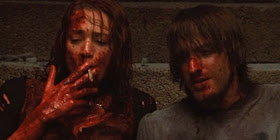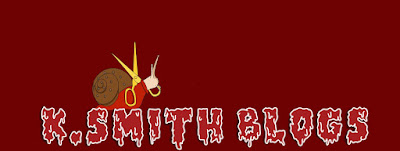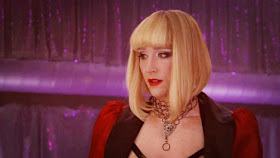[
Reader disclaimer: this piece may contain spoilers and material of a sensitive nature].
 |
| The Human Centipede: First Sequence (2009) |
You decide to sit down and watch a horror film: what's your go-to? Some people are psychological fans, others want to see demons possess people, but some of you twisted bitches are like me and want to see body parts go flying. There are a few subgenres for that: splatter, banned, torture porn, body, Lovecraftian, even snuff horror. They're all good in their respective ways but how do you quantify how much gore you want to see on screen?
I looked at three categories of horror films and put them in ranking order. The classics, the modern marvels and what's known in most circles as "extreme horror", often depicted as the most depraved, disturbing and downright bloody iterations of the genre. A score of 1 to 4 is considered tame, 5 to 7 is moderate, and 8 to 10 would be extreme.
I'd like to point out here, though, that these are just my personal takes and not something to take as gospel. I am somewhat biased in that I prefer gorier films but I can objectively advise you on what is gorier than others: with that being said, let's jump in.
(I'd also like to note that none of the films included scored a 1, the lowest ranking, but there are films out there with minimal gore, such as It Follows (2014)).
The Classics
 |
| The Thing (1982) |
The Shining (1980): 2/10
This famous Kubrick classic might be one you haven't watched (I don't know why you wouldn't have) but, if you were considering giving it a go, you'll be surprised to know that The Shining isn't particularly gory at all. It has disturbing imagery galore with body horror interspersed, but the body count stands at a measly one person, and the crippling insanity that Jack Nicholson brings to the table will freak you out much more than the elevator scene.
The Exorcist (1973): 3/10
Again, if you haven't seen this one, then where have you been? The Exorcist is regarded, perhaps, as the most famous horror film to boot but you'd be wrong if you thought this film was anything other than deeply psychological and rooted in the supernatural, as opposed to sitting comfortably in the gore section. There are some scenes (the crucifix scene in the bedroom is the one to watch out for) that incorporate gore but not hugely: this one will just have you paranoid that a demon is going to get you, not that your limbs are going to be cut off.
I Spit on Your Grave (1978): 5/10
One of the most famous rape-revenge films, I Spit on Your Grave is visceral, unnerving and badass. However, for a film that structures its entire premise on bodily violation and the physical revenge of such, there isn't a great deal of gore. Perhaps its most iconic scene is the "bathtub sequence" but, even so, we cut away before we see anything of real significance: this was more or less rectified in the remake but it's just a shame that the remake was nowhere near as good as the original.
The Evil Dead (1981): 6/10
Sam Raimi's magnum opus, other than clearly the fantastical Spider-Man 3 (2007), is a great summer flick to watch with your friends: it's a horror movie where blood runs like beer on tap and provides one-liners you'll be quoting for years to come. It's gory, yes, but leaps and bounds behind some of the other entries on this list: it also suffers from the 80s curse of fake blood cheapening the effect by becoming less and less realistic as the film ages. Still, a lot of bloody fun (pun intended).
A Nightmare on Elm Street (1984), Day of the Dead (1985), The Fly (1986) and The Texas Chainsaw Massacre (1974): 7/10
These four films certainly stray into the moderately gory territory. A Nightmare on Elm Street is arguably the bloodiest of the seven installments, with blood geysers and ragdoll bodies solidifying itself in horror history forever.
Day of the Dead, my personal favourite of the original Romero trilogy, has a wicked autopsy scene and features some pretty gruesome deaths throughout.
The Fly is just straight-up disgusting, and body horror doesn't necessarily equal gore, but the acidic spit scene is something akin to the Nazis losing their faces in that equally disturbing part of Raiders of the Lost Ark (1981). Although tragic, this film is most definitely and intensely graphic.
The Texas Chainsaw Massacre is, without a doubt, a horror masterpiece. A story of people terrorised by a family of murderous cannibals? One of which is based on real life serial killer Ed Gein, who wore his victims' skin as a makeshift mask? Gross. I love it. TTCM will make you avoid hitchhikers and meat hooks for the rest of your life, I'll tell you that.
Hellraiser (1987) and The Thing (1982): 8/10
Two horrors close to my heart, we close out the "classics" section with Hellraiser and The Thing, two films equally talented in evoking big reactions from its intended audience.
Hellraiser successfully meshes physical gore with masochistic pleasure, providing us with not only one iconic villain (Pinhead) but two (Frank). Frank's reanimation sequence is still one of the most awe-inspiring things I've ever seen in a horror movie, despite its aged appearance: it'll have your skin crawling (if you have any).
The Thing is a film, much like Hellraiser, that you probably have never seen but don't have to because it's everywhere in pop culture. The deaths are gnarly, the creature is freakishly abnormal and terrifying but best of all, the suspense will keep you on your toes through the runtime.
The Modern Marvels
 |
| The Cabin in the Woods (2011) |
Us (2019): 4/10
I adore this film. I adore both of Jordan Peele's films. However, horror in Peele's filmography doesn't derive from what's explicitly shown to us but by connotations woven throughout his narratives: for that reason, Us doesn't score particularly high on the gore scale. Although it is by far bloodier than Get Out (2017), the violence is not the epicentre of the story, moreover it is a gradual unravelling of shocking and fear-inducing events. A splash of blood here and there but nothing too gory.
Audition (1999) and Hereditary (2018): 6/10
One is a staple of j-horror, one is a classic before its time. Audition is a fantastically twisted psychological film that features some messed-up scenes involving some feet and vomit (don't ask) and Hereditary may as well be known as "that one film with all the neat decapitation", but both (despite the removal of body parts) are actually fairly tame when it comes to gore: it's moderate, and unsettling, but again, not really the main focus.
The Cabin in the Woods (2012): 7/10
The best way to describe this film would be a loving homage to the 80s, placing a contemporary spin on what we love about creature features and good ol' slashers. There's blood aplenty but the true sentiment lies in what The Cabin in the Woods pays tribute to, as opposed to who or what they kill on-screen: that being said, there's a lot of gory fun to be had. It's a moderate amount, a respectable amount if you will, which will appease the average horror fan and intrigue the general movie-goer.
The Extreme Ones
 |
| Martyrs (2008) |
Teeth (2007) and The Human Centipede: First Sequence (2009): 3/10
Teeth is actually the lowest ranked of this section for a very good reason: although it's a wonderful portrayal of an empowered female character and a biting, satirical commentary on gender division and sexual control, it's surprisingly tame in terms of gore. We see a few *ahem* "members" being removed but, other than that, the gratuitous violence derives from male entitlement and the horrors of male patriarchy. Great flick, just not very gory at all.
Another film you might be surprised to see ranked so low is the first Human Centipede: it's undeniably vulgar and unsettling, but when we look at it through our red-tinted lens, the gore just isn't there. Bodily fluids, no matter how disgusting they are, don't really constitute gore and even if it did, we don't see much of it on-screen. The Human Centipede is a film founded entirely in its shock factor, rather than its visceral reimagining of horror. It's gross, yes. But gory? Not really.
Antichrist (2009): 5/10
Lars Von Trier: you either hate him or you love him. Maybe you just respect that he's a clever filmmaker yet an all-around terrible human being. Either way, his film Antichrist is up there with the other extreme legends for being one of the most eye-boggling movies to date, an impressive feat considering it's not even technically a "horror" film (I'd classify it more as a psychological thriller/horrendous fever dream).
To say it's gory would be a misstep: it's not, as such, but the body horror that is there is pretty gruesome (you'll be crossing your legs and looking away from the screen on more than one occasion).
Cannibal Holocaust (1980), Dead Snow (2009), Hostel (2005) and Ichi the Killer (2001): 8/10
These four films set the bar in the extreme categories: Cannibal Holocaust is legendary, Hostel helped solidify torture porn in the modern genre, Dead Snow gave us Nazi zombies and oodles of fun and Ichi the Killer, though not as well-known, is by far the craziest j-horror flick out there.
Hostel and Ichi share similarities in their depravity: it's calculated, sadomasochistic and hard to watch. The gore wavers from a simple slash of the Achilles heel to a man's face being sliced off like a carrot through a vegetable grater. It's fun, it's mad and it's a lot. Dead Snow is similar to these two films, in that respect, but it's not calculated gore. There are buckets of blood, entrails pulled out and swung about, flesh-eating zombies tearing off body parts...if you want to just see people being annihilated, this film is for you.
Cannibal Holocaust, though despondent and violent, is in a different league to the rest of them. It is indeed gory, you've probably all heard about the legal problems director Ruggero Deodato ran into post-release, but the more disturbing part is not the fictional deaths of on-screen natives but the documented murder of real animals that is left in the film (vegans and vegetarians should stay clear of this one, for sure).
A Serbian Film (2010) and Braindead (1992): 9/10
Now, you might be wondering why on earth these two are paired together, seeing as one is a splatter-comedy and the other is just...beyond reason. But in all honesty, I'd argue that both sit firmly at a 9 when it comes to gore.
A Serbian Film is, evidently, not for the faint of heart. Such themes shown explicitly on-screen are necrophilia, "newborn porn" and rape: this, plus a hearty douse of gore, is a lot for movie goers. I'd only ever recommend seeing this film if you're able to stomach it and the same goes for Braindead (or otherwise known as Dead or Alive).
Braindead makes Dead Snow look pathetic in comparison to the sheer amount of guts, blood and pus that it thrown your way. The lawnmower scene at one time held the record for most blood used in a horror film, though I'm pretty sure the Evil Dead remake took the baton for that one back in 2013. Either way, both films are incredibly gross and feature gore only for the truly daring fans.
Martyrs (2008): 10/10
I know already that some people are going to disagree with me here. Surely, you must be thinking, A Serbian Film is worse than Martyrs. And in terms of depravity, I'd agree with you, but that's not what we're looking for today.
Martyrs is an endurance test, flinging the viewer headfirst out of their comfort zone and into the world of New French Extremity, a shockingly raw and upsetting type of horror. It pulls no punches, spares no feelings and never relents on both the physical violence nor the psychological torment of its characters.
Plasma doesn't gush like it does in The Shining, guts aren't pulled out like bunting up a magician's sleeve as it does in Dead Snow, but Martyrs is arguably unparalleled in its ability to chip more and more of its own humanity away to reveal its corrupted and bloodied nature. A Serbian Film is only there to shock you: Martyrs will make you question reality (and possibly vomit at the same time).
- K





























